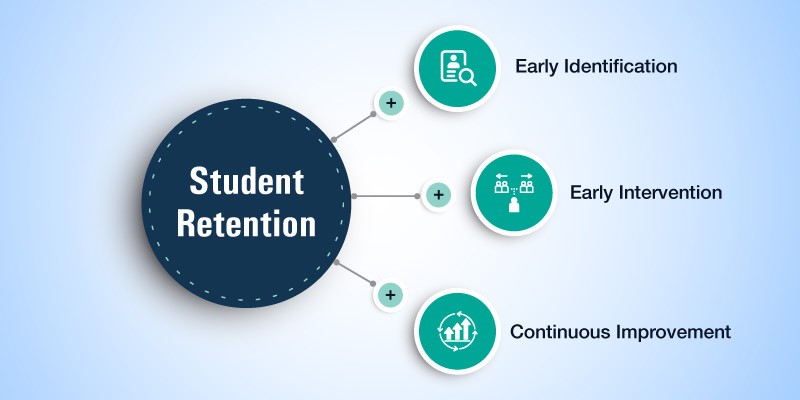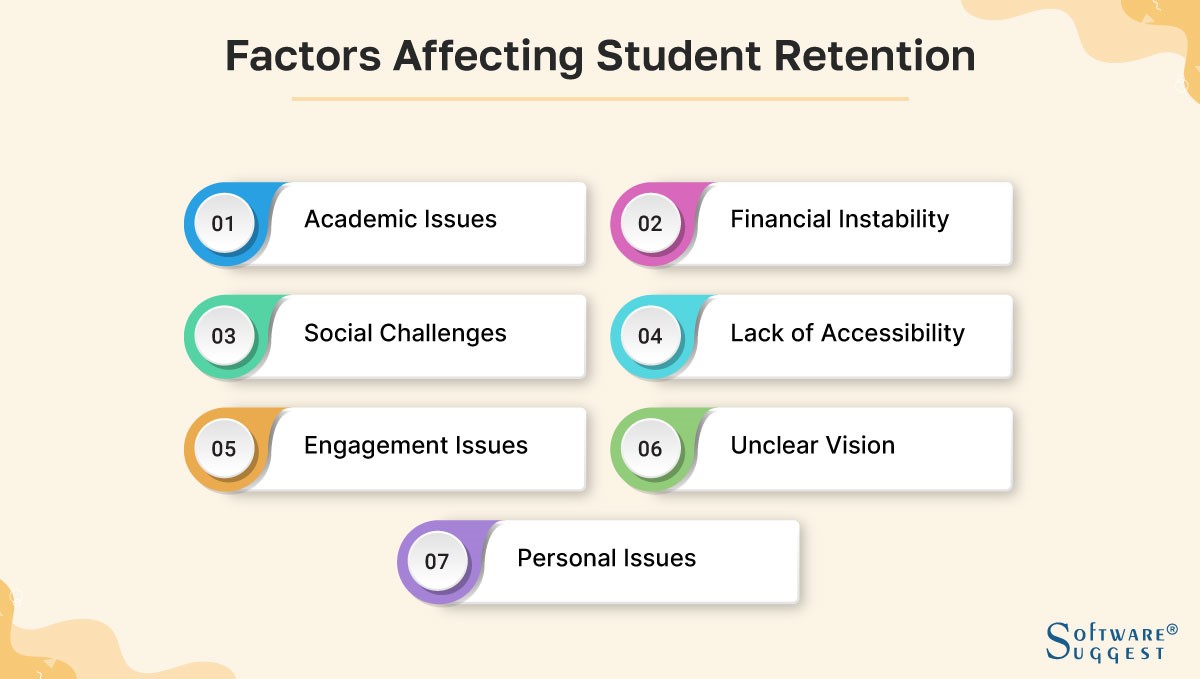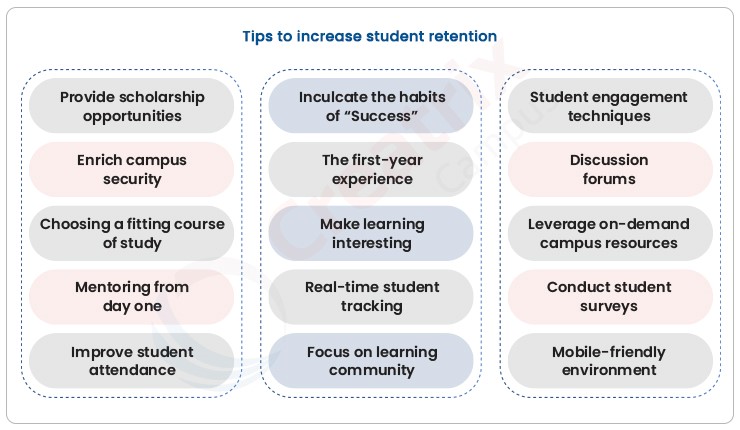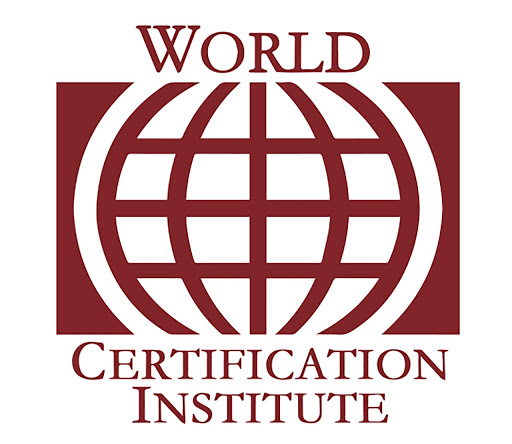Research reveals that the retention rate for private or public schools and colleges dealing with higher education is 76.3% which means that every 1 out of 4 students left their institution to study elsewhere or nowhere at all.
The numbers suggest that retaining students in higher education establishments can be a tricky task. However, it is not entirely impossible if you know the root cause behind the students leaving their studies midway. If you are an academic leader looking to improve student retention, this blog post is just for you. Keep reading on to learn what are the factors affecting student retention and how you can tackle the issue better.
What Is Student Retention
Student retention refers to an institution's ability to maintain students' enrollment from the beginning of their academic journey until they complete their program.

From the student's perspective, high retention signifies a satisfactory experiential learning process and the achievement of self-defined goals. Conversely, from the institution's standpoint, high retention indicates that students are content with the provided support and engaged learning environment. It is a vital aspect for higher education institutions as it influences the graduation rates showing how well an organization is doing for its students.
Importance of Student Retention in Higher Education
Student retention is particularly crucial in higher education institutions. The prevalence of dropouts has surged, especially during and post the pandemic. Influences from social media "influencers" coax students into pursuing money-making ventures, diverting their focus from education and leading to abandonment. This escalating dropout trend is a concern for both students and institutions. Dropouts encounter limited earning prospects, while institutions grapple with decreased revenue and reputation.
Addressing these challenges demands a comprehension of student concerns and tailored solutions. By employing effective educational management, institutions can ensure sustained student retention, encompassing enrollment to graduation. Notably, college student retention, especially in community colleges, has plummeted post-pandemic due to inadequate student resources and support services. To counteract this decline and regain control, institutions must implement student retention strategies to rekindle students' interest in education and boost revenue.
Hey, do you follow us on Social Media? We regularly share upgraded educational content, tips, feedback and more. Check us out by clicking the profiles here - Facebook / Twitter / LinkedIn / Pinterest / Instagram / YouTube
Factors Influencing Student Retention
Crafting effective retention strategies necessitates a comprehensive understanding of factors prompting students to withdraw. Identifying these factors paves the way for implementing strategies that yield desired results.

The following are key elements impacting student retention:
- Academic Challenges
Students grappling with academic difficulties are more likely to drop out. Factors such as study aversion, demanding courses, and ineffective time management contribute to academic struggles. Institutions should provide robust support mechanisms to address these challenges.
- Financial Instability
Financial constraints are a major impediment to continued education. Scholarships and financial aid aren't universally accessible, making affordability a retention-inhibiting factor.
- Social Hurdles
Fostering an environment that promotes socialization and extracurricular involvement is pivotal. Institutions that nurture a sense of belongingness and self-esteem through community engagement can mitigate social challenges.
- Limited Accessibility
Inadequate teacher-student interaction impedes problem-solving and leads to isolation. Students unable to connect with educators lose interest in learning, hampering retention.
- Engagement Deficiencies
Insufficient engagement leads to a waning interest in education. When students disengage from learning activities, their performance falters, jeopardizing their educational journey.
- Unclear Direction
Lack of clear career goals can result in poor course choices and mid-program switches, squandering resources and dampening prospects.
- Personal Issues
Personal concerns like health, family, or work can overwhelm students, compelling them to abandon their studies without adequate support.
Strategies to Enhance Student Retention in Higher Education
Formulating effective retention strategies is imperative to curb escalating dropout rates. These strategies aim to address retention-influencing factors and enhance engagement.

The following strategies can boost student retention:
- Define Student Success
Articulating post-education goals and achievements to students motivates them to pursue learning. The clarity in objectives provides a roadmap for academic success. Pre-enrollment orientation sessions facilitate connections among students, teachers, and peers. Familiarity with campus services fosters community bonds, mitigating feelings of isolation.
- Track Progress Effectively
Enabling students to monitor their progress fosters focus. Equipping them with study plans and to-do lists enhances progress tracking and ensures success. Apart from classroom engagement, extracurricular activities should be encouraged. Utilizing campus management software can facilitate effective event organization, enriching the student experience. Involving parents in monitoring academic progress maintains student engagement and also contributes to retention.
- Implement Support Programs
Supporting struggling students through detailed interventions and tailored solutions enhances their experience and connection with mentors. Long-term commitment necessitates a sense of belonging. Institutions can establish communities and support programs to strengthen student bonds and provide necessary assistance. Assurance of scholarships and post-education placements also alleviates financial concerns and influences retention by securing prospects.
- Seek Regular Feedback
Gathering feedback from students aids in addressing challenges promptly and refining grievance resolution processes. Meeting students' requirements fosters a supportive environment, reducing attrition and boosting graduation rates. Furthermore, adopting flexible study patterns reduces stress, ensuring student well-being and improving retention.
Ready To Take Your Student Retention Strategy To The Next Level?
Student retention and recruitment are vital for educational institutions. It is gaining prominence, combining marketing and communication strategies to attract and enroll qualified students, bolstering revenue and reputation.
Thus, institutions must aim to enroll the best talent to generate good revenue and enhance the reputation of the organization. Furthermore, all school leaders must equip themselves with a PG Diploma in Educational Leadership to understand the student scenario better and act accordingly. Employing comprehensive strategies can create a supportive learning environment that diminishes dropout rates and enhances institutional success.
We believe education should be accessible for everyone. That’s why we don’t charge for our blogs. Find the right course that will help you in your career with us, contact us at - +91-6292137532. You can mail us at act@asiancollegeofteachers.co









